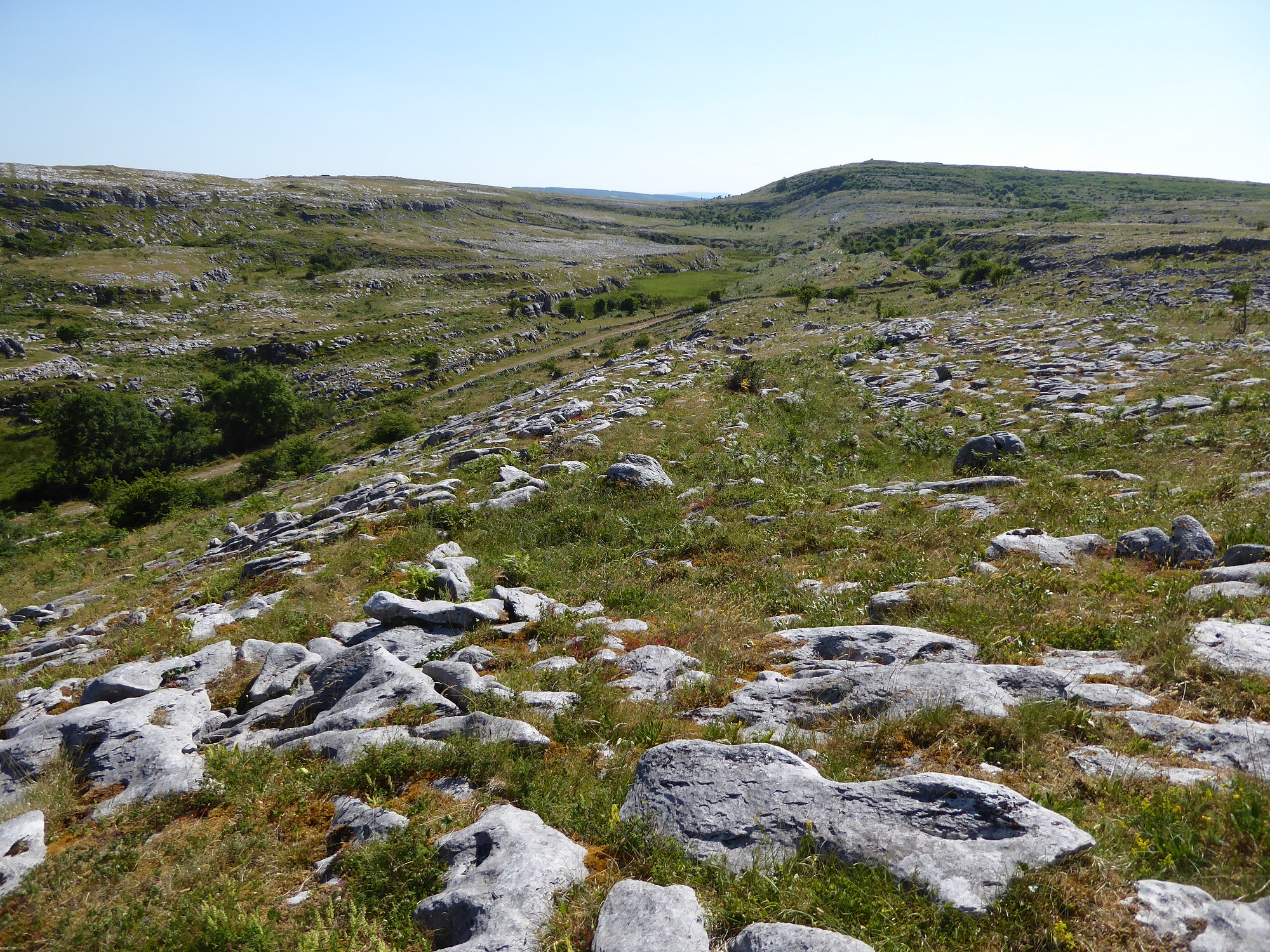
The Burren is a region in North County Clare and South Galway. It is a karst landscape containing exposed limestone. The Burren as it appears today is mainly the result of the last glaciation and the impact of human activity, especially farming. It is a remarkable landscape, containing a variety of habitats that belies the seeming uniformity of appearance when viewed from a distance, particularly during winter. In addition to eye-catching geological features, the area has a range of habitats that add enormously to the region’s biodiversity and international reputation. This article focuses mainly on the value of scrub and limestone grassland for butterflies and moths, particularly in areas where these habitats exist close together.
Scrub is a broad term and includes areas that are at least 50% covered by shrubs, stunted trees or brambles. The term includes dense growth with little ground vegetation. The canopy height is usually below 5m. The scrub of most value to butterflies is open scrub on lightly grazed, herb-rich grassland that receives good sunlight. Scrub management is carried out by occasional burning, manual cutting or cutting using machinery, sometimes followed by herbicide application. The most important habitat in Ireland for butterflies is the open scrub on calcareous grassland in the Burren in County Clare and Galway. The main scrub components present in the Burren are Common Hazel Corylus avellana, Common Hawthorn Crataegus monogyna, Common Blackthorn Prunus spinosa, Bramble Rubus fruticosus agg. and erect or scrambling roses Rosa spp., in addition to several willows Salix spp., Ling Calluna vulgaris, Guelder Rose Viburnum opulus, Common Holly Ilex aquifolium, occasional Juniper Juniperus communis and Common Yew Taxus baccata.
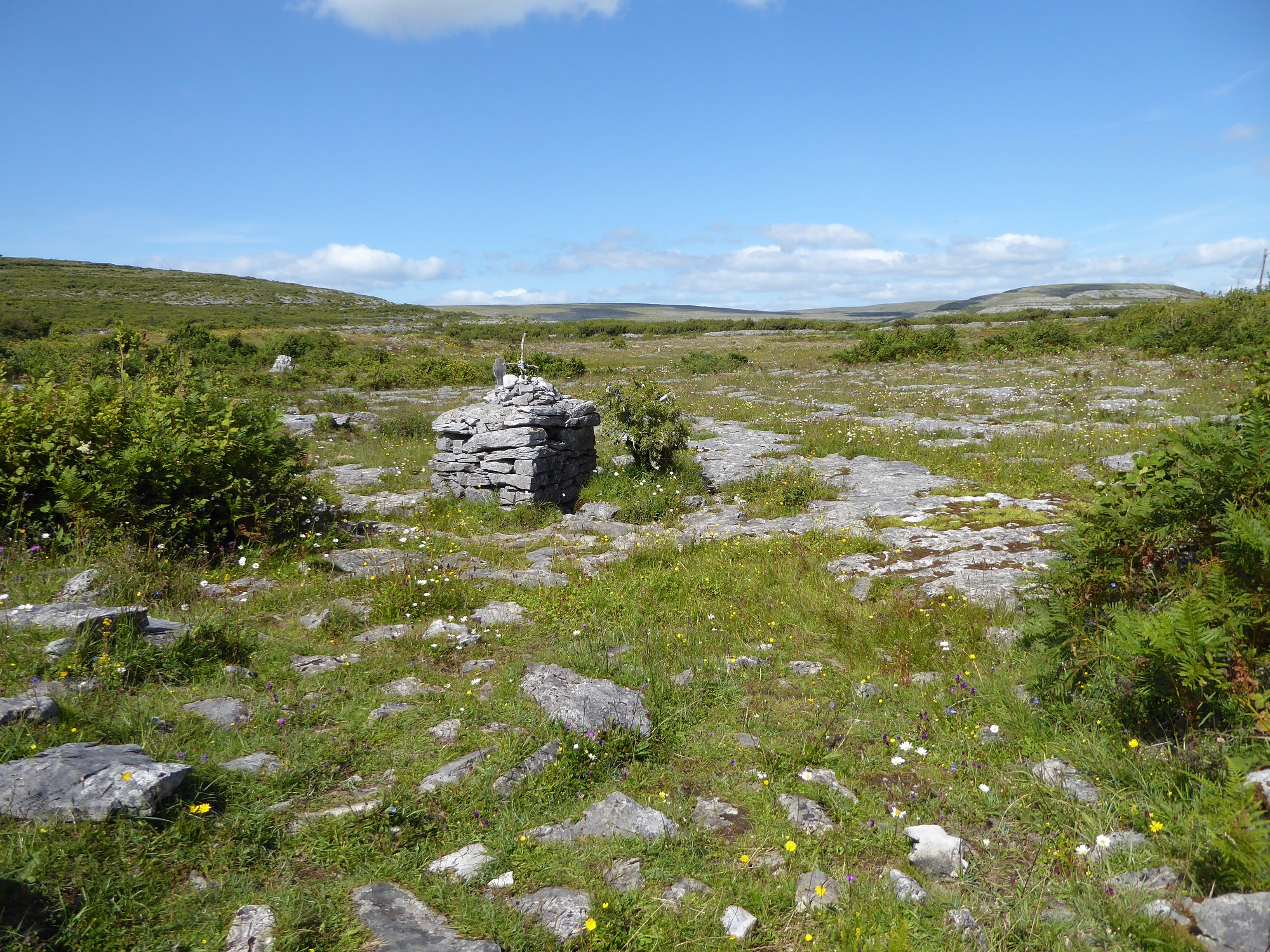
The grassland in the Burren clearings is often rich in flora, especially clovers Trifolium spp., violets Viola spp., Common Knapweed Centaurea nigra, Devil’s-bit Scabious Succisa pratensis, Selfheal Prunella vulgaris, Common Bird’s-foot Trefoil Lotus corniculatus, Cat’s-ear Hypochoeris radicata, Lady’s Bedstraw Galium verum and Oxeye Daisy Leucanthemum vulgare. The more calcareous grasslands are characterised by broadleaved herbs such as Cowslip Primula veris, Greater Knapweed Centaurea scabiosa, Kidney Vetch Anthyllis vulneraria, Mountain Everlasting Antennaria dioica, Yellow-wort Blackstonia perfoliata, Salad Burnet Sanguisorba minor and Carline Thistle Carlina vulgaris, and may also be important for orchids, including Ophrys and Orchis spp.
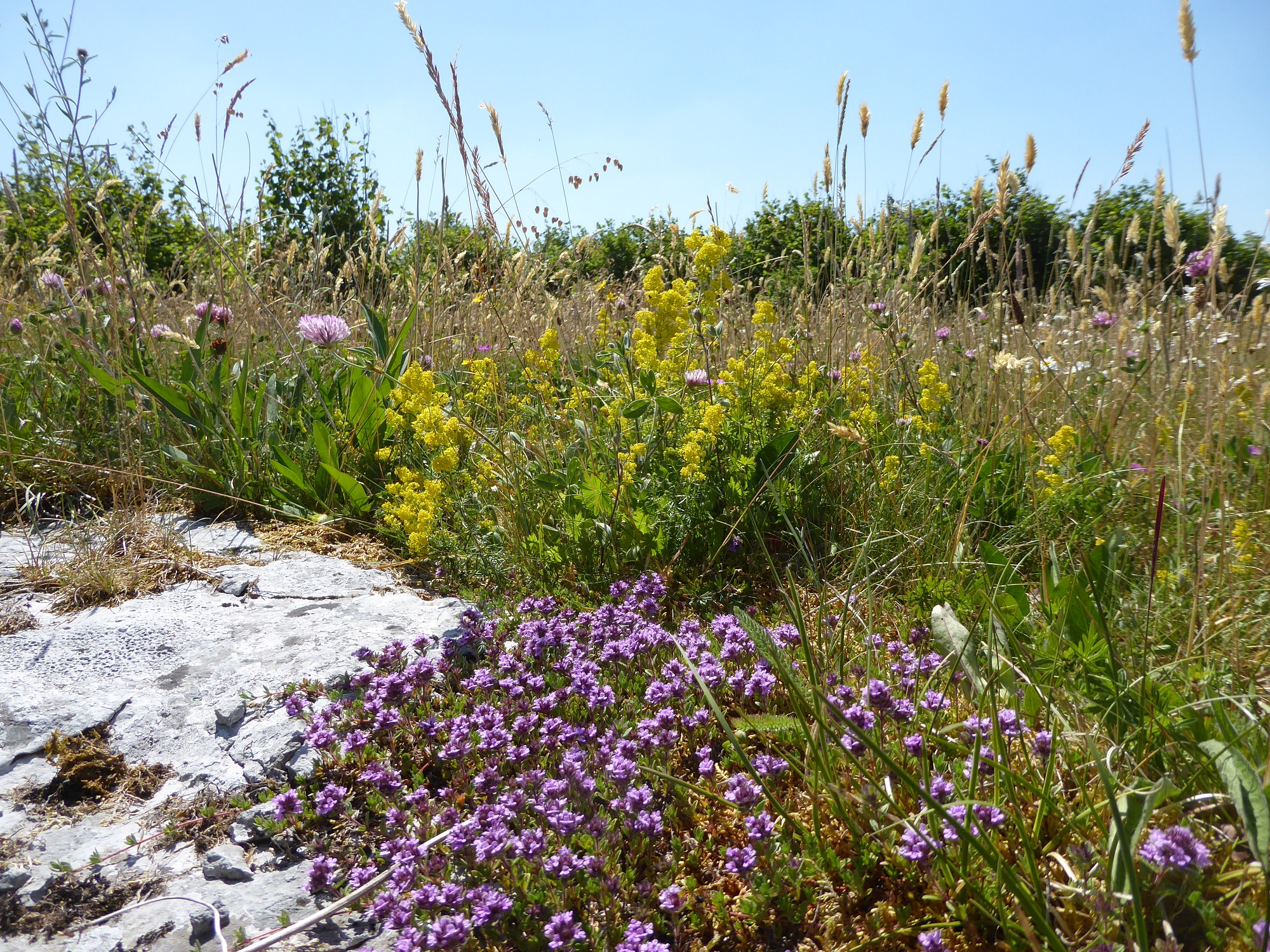
Grasses present often include fescues Festuca spp., Sweet Vernal-grass Anthoxanthum odoratum, Crested Dog’s-tail Cynosurus cristatus, Cock’s-foot Dactylis glomerata and Yorkshire-fog Holcus lanatus. Grasses that are indicative of strongly calcareous soils include Downy Oat-grass Avenula pubescens, Yellow Oat-grass Trisetum flavescens, Blue Moor-grass Sesleria caerulea and Quaking-grass Briza media.
These scrub and grassland mosaics are used for breeding by scrub/woodland and grassland butterflies. The butterfly species recorded breeding on herbs and grasses in open scrub in the Burren are Dingy Skipper Erynnis tages, Wood White Leptidea sinapis, Common Blue Polyommatus icarus, Small Tortoiseshell Aglais urticae, Peacock Aglais io, Red Admiral Vanessa atalanta, Painted Lady Vanessa cardui, Pearl-bordered Fritillary Boloria euphrosyne, Dark Green Fritillary Speyeria aglaja, Silver-washed Fritillary Argynnis paphia, Marsh Fritillary Euphydryas aurinia, Speckled Wood Pararge aegeria, Wall Brown Lasiommata megera, Grayling Hipparchia semele, Meadow Brown Maniola jurtina, Ringlet Aphantopus hyperantus and Small Heath Coenonympha pamphilus.
The species recorded breeding on shrubs in open scrub in the Burren are Brimstone Gonepteryx rhamni, Brown Hairstreak Thecla betulae, Purple Hairstreak Favonius quercus, and Holly Blue Celastrina argiolus.
Separating the species breeding in open scrub into (a) herb/grass feeders and (b) species feeding on shrubs ignores the complex habitat associations of several of the species listed here. The shade, shelter, and leaf litter provided by scrub influence conditions in the grasslands. This is vital for Lepidoptera, especially for the life stages lasting several months. The role played by scrub varies according to species, the time of year, and features such as the height, structure, composition, and management of the scrub and sward.
The Marsh Fritillary is a locally distributed, generally scarce species that requires grassland containing at least a 25% density of the larval foodplant Devil’s-bit Scabious, with the plants growing close together. The grassland that is most favoured has a sward height of 12-25cm. Some occupied swards are taller and even quite rank, but the foodplant is unshaded. The sward usually has tussock-forming grasses and flowers. There is usually some light cattle or horse grazing to maintain the grassland. In swards that are strongly exposed to the weather and that are moderately grazed during the summer, some sheltering scrub is important for the Marsh Fritillary. This species dislikes exposed grasslands unless there is a tall, (c.25cm) well-developed sward that is grazed irregularly and extensively or throughout the year if grazed extensively. Litter from easily warmed dead vegetation, especially from grasses, but sometimes from mosses, scrub foliage, and bracken, must be present for the Marsh Fritillary to be able to make use of the sward for breeding.

The scrub is also used by the Dark Green Fritillary. This eye-catching, dynamic species flies mostly from mid-June to mid-August. Eggs are laid on or near violets growing in grassy places with a fairly tall, well-developed sward, in open, exposed grassland, in sunlit clearings in open scrub, but also at the immediate edge of scrub where a lower, patchier sward exists. After about two weeks, the newly hatched larva eats the eggshell and immediately enters diapause (a rest phase with no feeding and little development), remaining in this state until March of the following year. Unless it has the shading effect of a well-developed sward or scrub, the unfed larva will desiccate in the summer heat.

The Wood White has a highly restricted distribution in Ireland, where it has been found only on carboniferous limestone, from near Newmarket-on-Fergus in south County Clare northwards to Lough Corrib, County Galway on its east and west shores. Its stronghold is the Burren. It is scrub-dependent, breeding on vetches, especially Meadow Vetchling and Tufted Vetch, that receive direct sunlight but that grow in intimate contact with scrub. The adult has a weak, fluttering flight, and the shelter afforded by scrub appears necessary for it. The larva needs access to direct sunlight, shelter, and shade throughout its development. When feeding is complete, it pupates in the scrub or on vegetation growing among the scrub. Medium-tall vegetation in intimate contact with scrub is crucial for this species.
In Ireland, the Pearl-bordered Fritillary breeds on Common Dog-violet Viola riviniana growing among open scrub and open woodland on the carboniferous limestone in the Burren, Counties Clare and Galway, and in similar habitat near the Burren. In Ireland, it is restricted to these areas. According to Nash et al (2012), it has been recorded in just twelve 10 km squares, 35 tetrads. In two of the 10km squares, on Inishmore and Inishmaan, where single individuals were seen, it appears that these were wanderers from the mainland.
The breeding habitat for the Pearl-bordered Fritillary is the same as that used by the Wood White. The larva requires shade and direct sunlight. Direct light is required by the larva for it to be active and for digestion while the shade is needed to cool it down. During hot sunny weather in summer, the larva feeds in strong sunlight but quickly retreats to a shaded location. Cooling shade is needed during the larva’s long diapause from mid to late summer until feeding resumes in March. Furthermore, unshaded violets wilt and turn yellow, which makes make them unsuitable. In part-shaded areas, the foliage remains green.
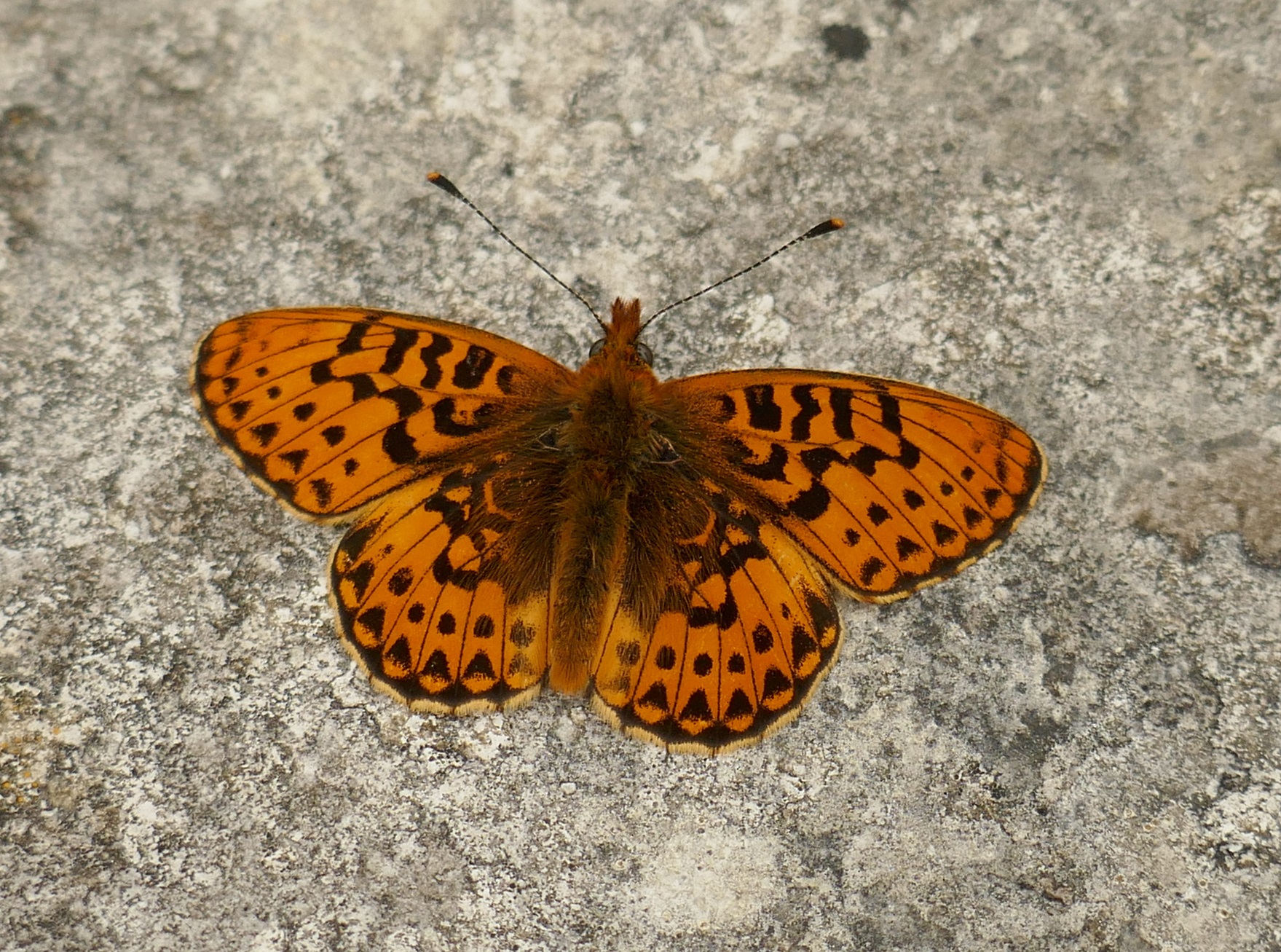
The question of why the Pearl-bordered Fritillary’s distribution in Ireland is limited to the Burren is an interesting one, with the answer likely to be found in the conditions needed by the larva. It needs the Common Dog-violet, usually with low herbs and dry moss on dry, free-draining, warm, sheltered, usually south-facing sunny habitats containing leaf litter build-up against scrub on open limestone rock. The larval micro-sites have low grass density; the grasses present are typically scattered tufts of Blue Moor-grass and fescue grasses containing standing and lying warm, dry litter, particularly in spring. Plant litter is used by larvae for basking, concealment, and over-wintering. It may be important for the larva to have Common Hazel leaf litter. Hazel produces a leaf litter that is substantial without shading the foodplant. Dead hazel leaves curl, producing hiding places for resting larvae. The dead leaf dries quickly, and the larva needs dry conditions (Harding 2021).
Two other features favouring the species are the frequent rainfall that prevents the foodplant from losing moisture while the free-draining limestone provides the dryness needed by the larva. Grazing by cattle or horses during winter and spring, and periodic scrub cutting, but not scrub clearance, is beneficial.
The adult feeds mainly in the clearings in the scrub, especially on Common Bird’s-foot-trefoil, Bugle Ajuga reptans, buttercups Rununculus spp., and Dandelion Taraxacum spp. Thus, the butterfly needs the grassy areas adjoining the scrub, as well as the shadier areas occupied by scrub.
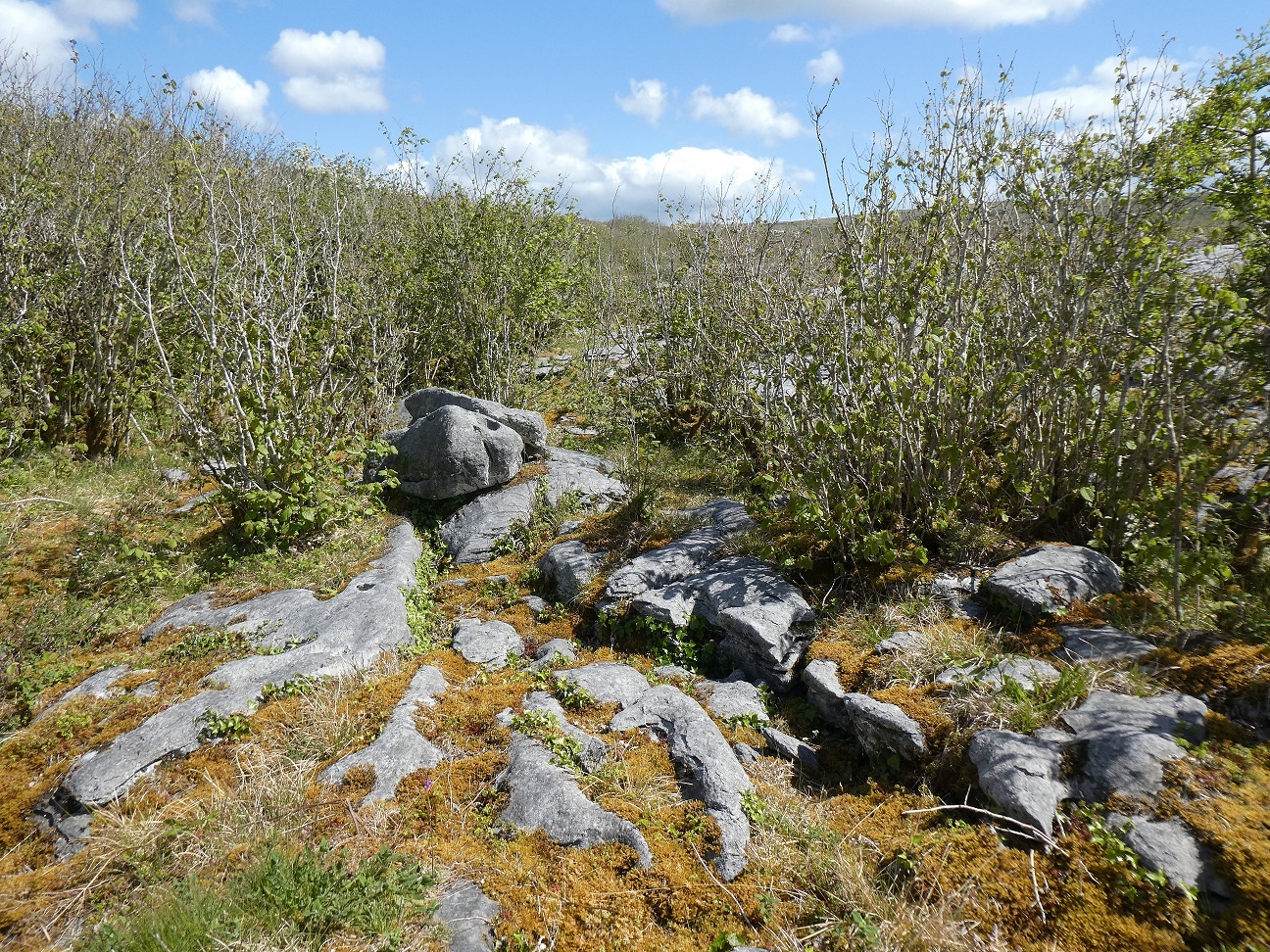
The Peacock, a species distributed throughout Ireland, uses the Stinging Nettle Urtica dioica as a foodplant, and it selects unshaded nettles growing close to scrub or woodland. It is possible that the scrub provides the warmth and shelter required for larval development. Fully fed larvae leave nettles to pupate on trees and scrub.
Speckled Wood, another widespread species, has a complex relationship with scrub. Known as a butterfly of hedges, scrub and woodland, it is our most shade-tolerant butterfly. The adult uses scrub for food (feeding on flowers such as bramble and Common Ivy Hedera helix, on ripe blackberries and aphid ‘honeydew’), for shelter from the rain and heat, resting and roosting, territorial perches, patrolling areas, mating stations, and dispersal routes. The butterfly breeds on native grasses growing at the edge of scrub, hedges, and woodland, but a seasonal difference exists in the egg-laying sites chosen. Early and late in the year, warm clumps of grasses in full sun are selected for oviposition, while during the summer heat, partly shaded lusher grasses in humid locations are selected. However, a female will adjust her choice of egg site according to temperature, so that grasses in shaded positions will be selected during hot weather in autumn.
Four butterfly species that breed on shrubs, Brimstone, Brown Hairstreak, Purple Hairstreak, and Holly Blue, use foodplants that receive direct sunlight. While often regarded as woodland species, none of these can breed within shaded areas of woodland or scrub. In the Burren, the eggs of the Brown Hairstreak are found on young growth on Common Blackthorn plants at the edge of a hedge, scrub patch or woodland edge that is unshaded and south-facing.
Some butterflies enter a prolonged rest phase in their adult state. Four of our butterfly species undergo reproductive diapause in summer; these feed to build fat reserves before entering dormancy (quiescence) until the following spring when conditions favour breeding. The Brimstone, Small Tortoiseshell, Peacock, and Comma pass the winter in cool, dry conditions in scrub and woodland. It is likely that the Small Tortoiseshell, Peacock, and Comma require dense scrub for over-wintering. For this part of their life cycle, scrub and woodland habitats are vital.
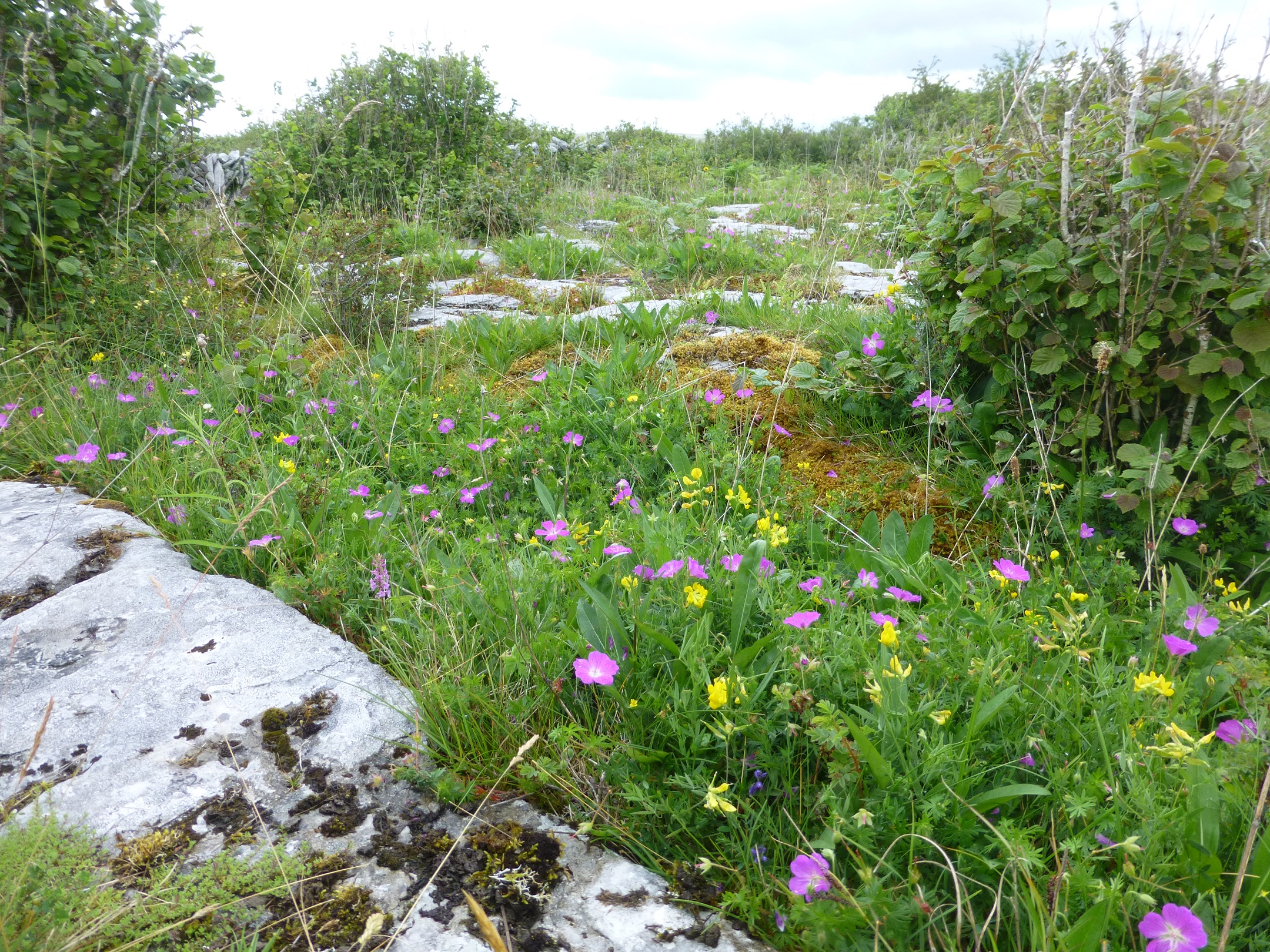
The removal of large areas of scrub over an extended area can produce severe survival challenges for rarer, scrub-dependent butterflies. Any remaining areas may be too small to support populations. Where suitable habitat patches are isolated, a species may modify its behaviour to secure its survival. There may be selection for sedentary individuals. Highly localised, sedentary populations are vulnerable to extinction arising from causes such as habitat destruction, bad weather, parasitoids, or perhaps inbreeding. Selection for more sedentary races of the Pearl-bordered Fritillary is suspected to have taken place in England in areas where the butterfly depended largely or fully on coppicing for its habitat (Thomas and Lewington 2014).
Climate change is expected to produce warmer, drier summers in Ireland. Many of the warmest years on record have occurred since 2000. According to the Copernicus European State of the Climate report in 2020, 11 of the 12 warmest years occurred since 2000. The projected decreases in rainfall for Ireland are largest for summer, with reductions ranging from 0% to 13% and from 3% to 20% for the medium-to-low and high emission scenarios, respectively. Projections indicate an increase of 1–1.6°C in mean annual temperatures, with the largest increases seen in the east of the country. Warming is enhanced for the extremes (i.e., hot or cold days), with the highest daytime temperatures projected to rise by 0.7–2.6°C in summer and the lowest night-time temperatures to rise by 1.1–3°C in winter (Nolan 2015).
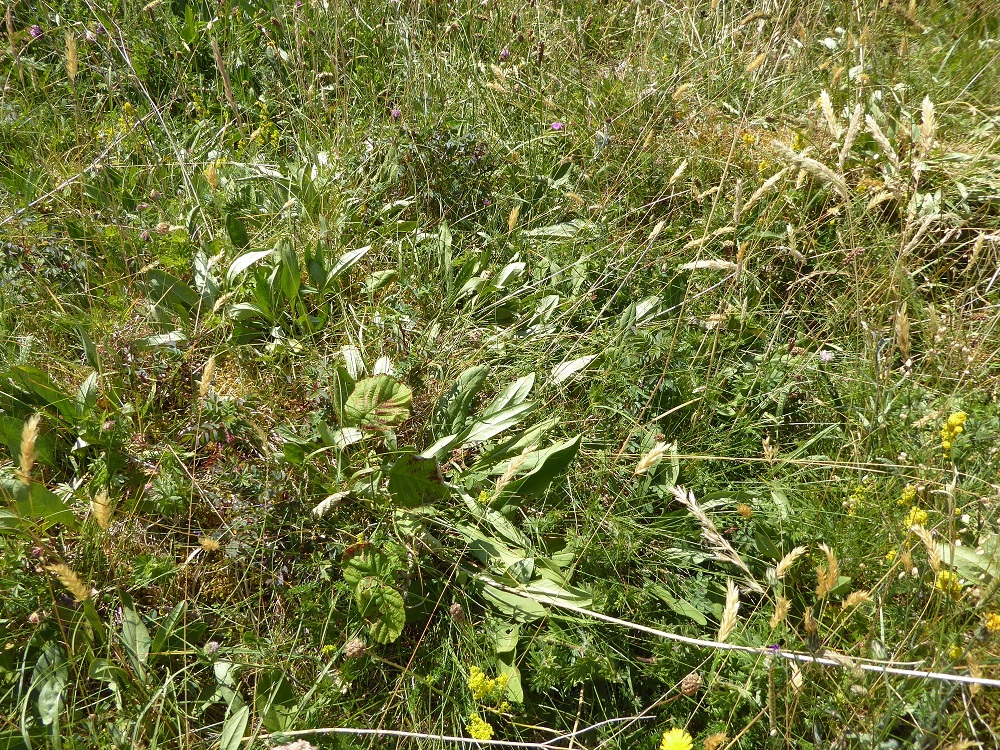
During recent hot, dry summers such as in 2018, desiccation of larval foodplants was observed in open, unshaded grasslands. During the hot weather, some species that usually frequent open areas during the day were observed sheltering in scrub. Interestingly, the Common Blue, which breeds on plants such as Common Bird’s-foot-trefoil growing in open grassland, was observed laying eggs on the foodplant growing in the shade. There may be several reasons for this untypical behaviour; the plants in open areas were in poor condition while in shaded areas they were not shriveled, the plants in shaded places were probably growing at the correct temperature during the heat of that summer, while during a more ‘typical’ summer, shaded plants will not support the larva. Finally, stress from extreme heat may be driving the adults to choose plants in less suitable micro-sites.
Breeding on plants shaded by scrub may be an adaptive behaviour by open grassland breeders under a warming climate. The increasing heat and dryness over the coming years may increase the importance of scrub for some Lepidoptera and other invertebrates.
The vast majority of Irish Lepidoptera are moths. There are about 1567 moth species recorded in Ireland with about 970 of these occurring in the Burren (D. Allen pers.com.). About 600 macro (larger) moths have been recorded. The following figures show the foodplants used by macro-moths; note that some species are polyphagous and use several of the following scrub species. 121 species have been recorded on willows, 96 species recorded on birches Betula spp., 61 species recorded on oaks Quercus spp., (the latter two tree groups are uncommon in the Burren scrublands), 26 species recorded on Aspen, 29 species recorded on Common Blackthorn, 36 species recorded on Common Hawthorn, 44 species recorded on Common Hazel, six species recorded on Purging Buckthorn and five on Alder Buckthorn (Waring et al 2004).

Hedges, scrub, and woodland are vital for our moth species, and not simply for larval foodplants. Moths use wooded habitats in similar ways to butterflies. One example is provided in a study by Coulthard et al. (2016) which showed that hedges are very important flight paths for moths. 68% of moths in the study were observed at 1m from the hedge, and of these 69% were moving parallel to the hedge. Hedges are believed to provide the sheltered corridors needed by flying insects in our generally open, farmed landscapes. This is likely to be especially relevant in open, exposed areas like the Burren.
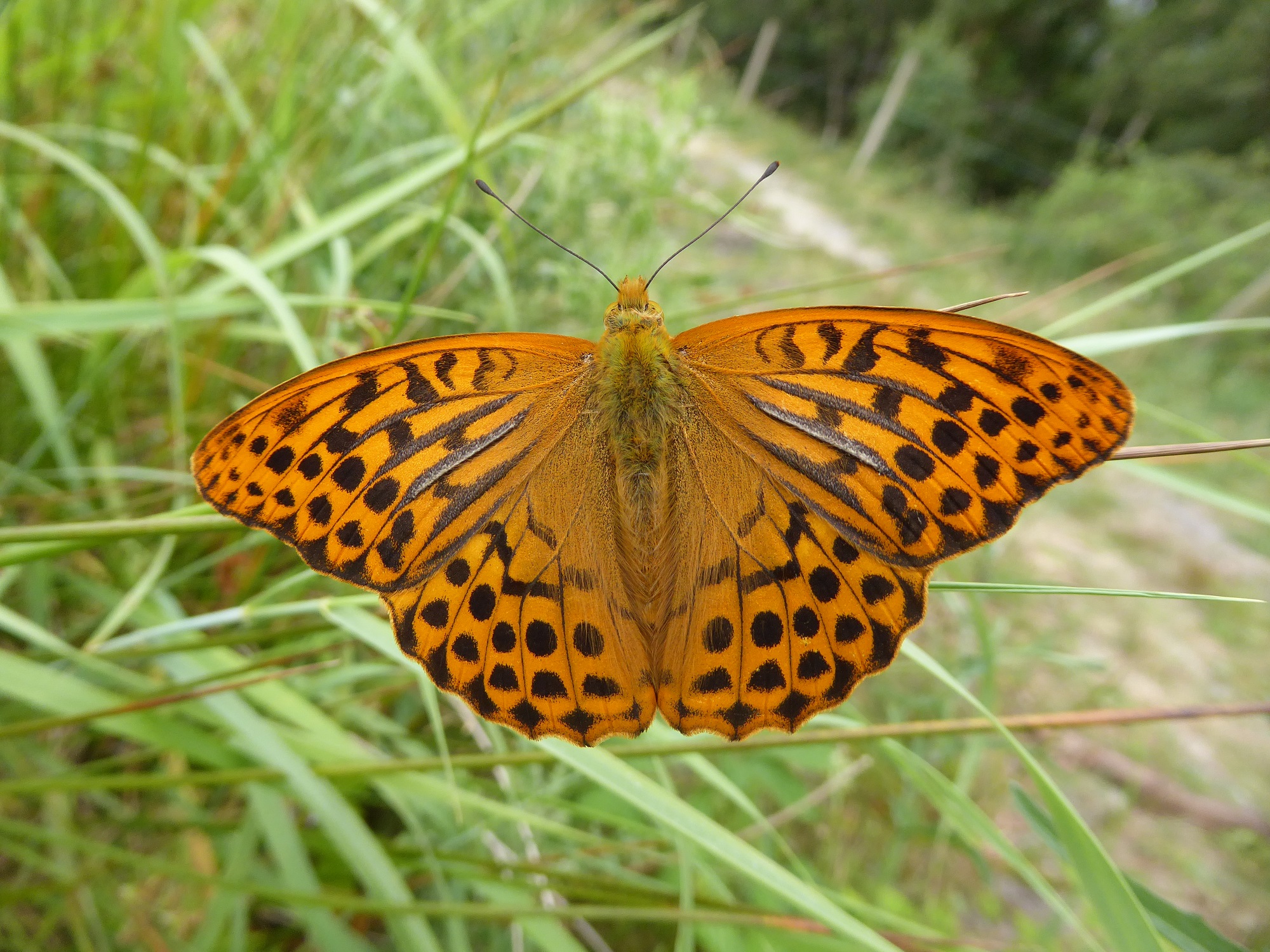
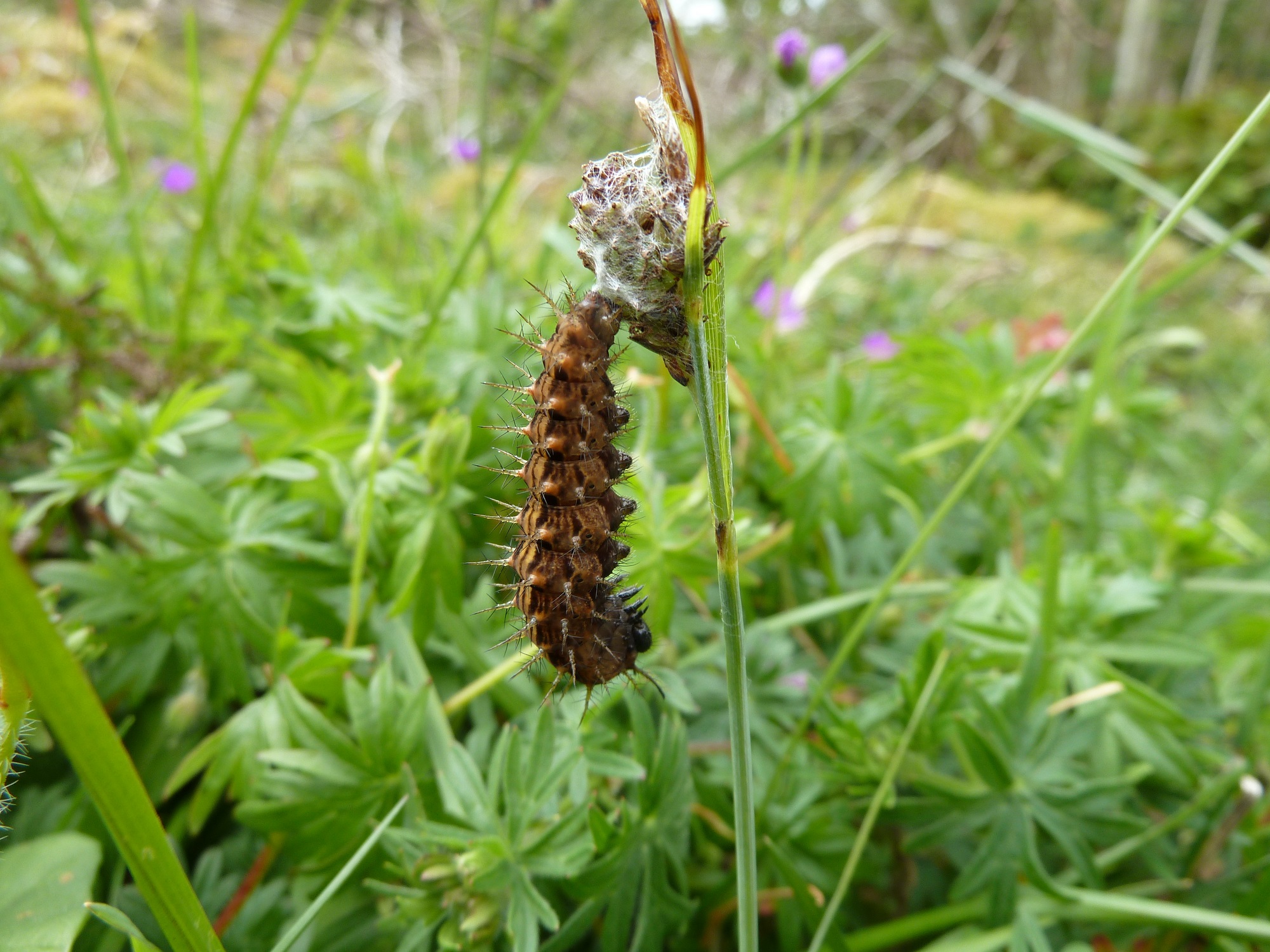
There is an overwhelming body of evidence that supports the idea that more heterogeneous habitats can support more species diversity (Broeker 2018). Habitat heterogeneity, or small-scale changes in resource composition and structural complexity, provides more possible niche space for organisms to occupy and exploit (Tews et al, 2004). The range of habitats in the Burren, especially in the eastern areas, where complex mosaics of fens, cutover bogs, grasslands, heaths, limestone pavement, woods, and scrub exist support more butterfly species than anywhere else in Ireland. The scale of the habitats supports connectivity/dispersal, and genetic diversity and provides a range of niches in the face of the impacts of climate change, offering the prospect of adaptation when species are confronted with survival challenges. Maintenance of these conditions not only supports biodiversity generally, it preserves the magnificence of the region, touching those who experience the Burren with “the joy of elevated thoughts” (Lines Composed a Few Miles above Tintern Abbey, On Revisiting the Banks of the Wye during a Tour. July 13, 1798).
References
Broeker, H. (2018) Habitat Heterogeneity, Morphospecies Richness, and Niche Exploitation in the Human Skin Microbiome. Online at https://www.lakeforest.edu/news/habitat-heterogeneity-morphospecies-richness-and-niche-exploitation-in-the-human-skin-microbiome, accessed 11 September 2022
Coulthard, E., McCollin, D. & Littlemore, J. (2016) “The use of hedgerows as flight paths by moths in intensive farmland landscapes”, Journal of Insect Conservation, vol. 20, no. 2, pp. 345-350.
European Commission (2020) Warming trend shows 11 of the 12 warmest years occurred since 2000, according to the Copernicus European State of the Climate report. Online at: https://climate.copernicus.eu/warming-trend-shows-11-12-warmest-years-occurred-2000-according-copernicus-european-state-climate, accessed 10 September 2022
Fossitt, J.A. & Heritage Council Ireland (2000) A guide to habitats in Ireland. Heritage Council/Chomhairle Oidhreachta, Kilkenny.
Harding, J. (2021) The Irish Butterfly Book. Privately Published, Maynooth.
Nash, D., Boyd, T. & Hardiman, D. (2012) Ireland’s Butterflies: A Review. Dublin Naturalists’ Field Club, Dublin.
Nolan, P. 2015. EPA Report: Ensemble of Regional Climate Model Projections for Ireland. EPA climate change research report no. 159. EPA: Wexford. (show me this citation)
Tews, J., Brose, U., Grimm, V., Tielbörger, K., Wichmann, M. C., Schwager, M., & Jeltsch, F. (2004) “Animal species diversity driven by habitat heterogeneity/diversity: the importance of keystone structures.” Journal of Biogeography, 31(1), 79-92.
Thomas, J. & Lewington, R. (2014) The Butterflies of Britain and Ireland. (Revised edition) British Wildlife Publishing, Dorset.
Waring, P., Townsend, M., & Lewington, R. (2004) Field Guide to the Moths of Great Britain and Ireland. British Wildlife Publishing, Hampshire.

